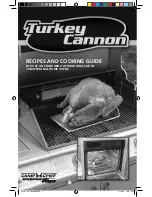
24
25
GETTING THE MOST FROM YOUR ROASTING HOOD
GETTING THE MOST FROM YOUR ROASTING HOOD
You may find it useful to purchase a meat thermometer
to help take the guess work out of cooking.
Meats such as beef, lamb, veal and pork should be
about 70˚C/160˚F when medium. Chicken and turkey
should be 85–90˚C/185–195˚F.
Most importantly, do not allow your barbecue to
overheat. Your hood is designed to keep the heat in,
and also requires constant monitoring.
Do not use more than 2 burners on high at any one
time. As a guide, for a 4 burner barbecue in moderate
weather:
Two burners on low produces 150°C/300°F
Two burners on medium produces 195°C/385°F
Two burners on high produces 240°C/460°F
For smaller barbecues, less heat is required. During
cold or windy conditions, more heat is required.
Finally, resist the temptation to keep opening the hood
while cooking. This will help to maintain a constant
temperature, and minimise cooking time.
OVE
RH
EA
TIN
G
W
AR
M
240°C
450°C
400°C
350°C
220°C
200°C
180°C
160°C
Maintain the right cooking temperature
These two charts tell you how hot and how long to cook various
types of meat, and the approximate burner settings to help you
achieve these results.
As you expect, there are many variables involved. A little experience
is all you’ll need to feel perfectly comfortable and in control of your
barbecue.
MODEL
BURNERS
Two burner Both burners slightly below medium
Three
burner
Middle burner off
Two outside burners to medium
Four
burner
Two inside burners off
Two outside burners to medium
Five burner Three inside burners off
One outside burner to high
Other outside burner to medium
Do not allow your barbecue to
overheat, as this may damage
some components.
TYPE OF MEAT
COOKING TEMPERATURE
APPROXIMATE COOKING TIMES
Beef
180°C/355°F
45–55min per kg
20–25min per lb
Lamb
180°C/355°F
45–55min per kg
20–25min per lb
Pork
170°C/340°F
55–60min per kg
25–30min per lb
Veal
160°C/320°F
40–50min per kg
18–23min per lb
Poultry
180°C/355°F
40–50min per kg
18–23min per lb
Seafood
150°C/300°F
20–30min per kg
9–14min per lb
HELP GUIDE
HELP GUIDE
Your BeefEater barbecue has undergone a series of quality
checking points prior to leaving the factory. Should you have
a problem with your appliance please refer to the help guide
below before calling your dealer or service person.
IMPORTANT
Shut off gas supply before performing any checks.
PROBLEM
CAUSE
CHECK
Barbecue will not light
Ignition system not working
Check to see visible spark at starter probe
- if no spark is present when control knob
is turned then the unit may need to
be serviced or replaced. Contact your
BeefEater dealer. Check that there is a
visible flame coming from the pilot
ignition tube. Check that the pilot ignition
tube is not blocked by spider webs
or insect nests. Clear obstruction as
required.
Turning on gas control too quickly
Allow at least 5 seconds for gas to flow
through burner before ignition.
No gas flow
Check that valve on gas cylinder is turned
on. Check that burner ports are free of
obstructions. Check that all gas injectors
are clean and free of obstructions.
Burners not assembled correctly
Check that burners are correctly
positioned in the barbecue frame.
Burner ports or throat blocked
Check that the burner ports are not
blocked by spider webs or
insect nests. Clean out as required.
Barbecue lights but goes out
soon after starting
Fuel supply turned off
Turn on gas valve at cylinder (LPG/
Propane) or shutoff valve
on gas line (Natural Gas).
Gas cylinder low or empty
Refill cylinder with gas (LPG/Propane).
Kink in gas hose
Check that the gas line is not kinked or
twisted.
Wind or breeze affecting operation
Ensure that the appliance is located out of
the way of wind.
Burners will not cross light
from one to the other
Check that cross light channel is in place.
Check that burner ports are free of
obstructions.
Low flame level or low heat
output
Burners will not cross light
Check you are running on correct gas (NG
or LPG/Propane).
Check gas injector size is correct.
Stainless steel discolours
From one to the other
Do not exceed maximum operating
temperatures.
Rusting of cooking surfaces
(standard cast iron only)
Clean and reseason cast iron cooking
surfaces.





































